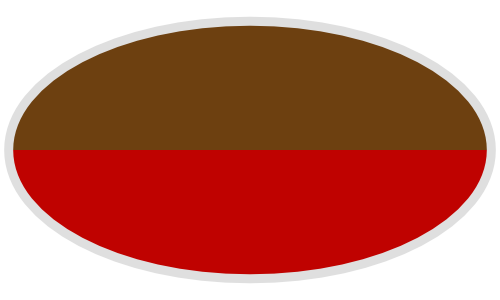The Current 39th Bn
39th Operational Support Battalion – Origins
The 39th Battalion was restored to the Australian Army Order of Battle on the 8th of August 2006. The significance of the date is the day in which the members of the 39th Battalion Association claim to be the true Kokoda Day, corresponding with the day the unit re-captured Kokoda from the Japanese, albeit briefly. This was the only time that Kokoda itself, the village that became synonymous with the campaign, was ever fought for by Australian forces and is why the Association celebrate Kokoda Day in August as opposed to November each year. 63 years after the 39th Battalion was disbanded on the 3rd of July 1943, and thanks to extensive lobbying by the 39th Battalion Association to the then Governor General of Australia, Major General, the Honourable, Michael Jeffery, AC, AO (Mil), CVO, MC (Ret’d), the unit was once again reinstated to answer the call.
The event was a significant occasion, marked by a ceremonial parade conducted at the Shrine of Remembrance, Melbourne. The Reviewing Officer was Major General the Honourable Michael Jeffery, AC, AO (Mil), CVO, MC (Ret’d). Distinguished guests included: Chief of Army, LTGEN Peter Leahy AC, 39th Infantry Battalion Association President Mr Alan Moore and surviving members of the 39th Infantry Battalion. More than 500 people attended the ceremony, with more than 50 veterans of KOKODA accompanied by many family members and one of the original Fuzzy Wuzzy Angels, Mr Frederick Soka, flown down from PNG as an honoured guest. This occurred on the sixty-fourth anniversary of the successful attack by the 39th Australian Infantry Battalion to re-capture Kokoda.
LTGEN Peter Leahy AC (Ret’d,) the Chief of Army during the period 2002- 2008, raised the Battalion due to the increased operational tempo at the time and the requirement of Army to prepare for a new era of deployments. He also acknowledged that the emblematic name of the 39th was given to this new unit to honour the legacy of the 39th Infantry Battalion which was disbanded in 1943. The Chief of Army and the Governor General both felt that it was particularly appropriate to pass on the number of the 39th to a force preparation unit because of the limited force preparation given to the 39th Infantry Battalion when it was reformed in October 1941 before their deployment to Port Moresby in January 1942.
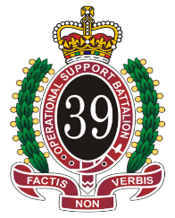
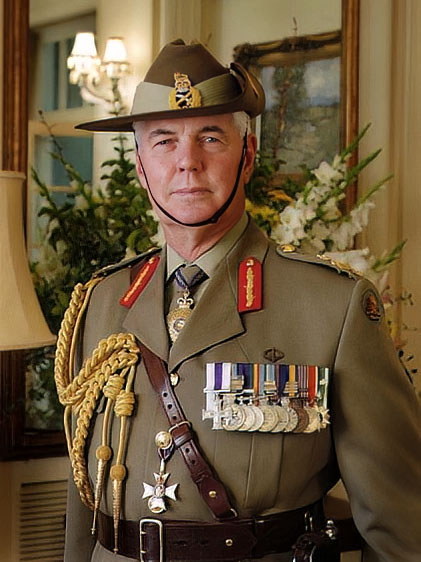

39th Battalion UCP colours are a grey-bordered oval with brown on top of red, signifying ‘mud over blood’
Although the new unit was never again going to be an Infantry Battalion again, it was given the right to adopt the following 39th Infantry Battalion symbols/accoutrements when it was raised. To this day 39 OSB has kept these symbols/ accoutrements:
-
- The unit colour patch (UCP)
- The unit badge (not to be used as a hat badge)
- The 39th Australian Infantry Battalion unit motto ‘Factis Non Verbis’ (Deeds Not Words).
- The unit flag (brown over red with 39 PSB badge in the centre).
- The 39th Australian Infantry Battalion Association Banner.
39th Personnel Support Battalion (2006-2014)
The 39th Personnel Support Battalion (39 PSB) was the original name granted to the newly re-raised 39th Battalion on the 8th of August 2006, when the Deployed Forces Support Unit (DFSU) changed its name. In 2005/2006, 39 PSB force prepared more than 5000 individuals for operational deployment. The unit was initially located in Building 307 on Randwick Barracks but in January 2007, 39 PSB moved into Building 217 at Randwick Barracks Sydney. The building complex was renamed ISURAVA Lines, in memory of one of the bloodiest battles fought by the 39th Battalion on the Kokoda Track.
39 PSB, initially commanded by LTCOL Daryl Clarke, was raised to coordinate the preparation and support of land based ADF elements deployed on overseas operations. It contained about 150 full time and part time personnel located in Sydney, Townsville, Darwin and Brisbane.
The mission of the 39 PSB was to provide force level personnel services support and individual force preparation training to designated ADF members in order to improve effectiveness of ADF personnel deployed on operations. The Deployed Forces Support Unit (DFSU) was renamed and designated as the Force Support Company (FSC) of 39th PSB.
From the outset, 39 PSB conducted five core force preparation courses for ADF operations and UN deployments. The supported operations were:
-
- Operation CATALYST/SLIPPER (Middle East, including Afghanistan)
- Operation ASTUTE (East Timor)
- Operation ANODE (support to regional assistance mission in the Solomon Islands)
- Operation PALADIN (Israel, Lebanon, Syria United Nations peacekeeping operations /UNTSO)
- Operation MAZURKA (Sinai, Multi United Nations Peacekeeping/Observer mission /MFO)
- Operation AZURE (Sudan United Nations peacekeeping operation /UNMIS)
39th Personnel Support Battalion Commanding Officers:
LTCOL D.S. Clarke, 08 August 2006 – 04 January 2007
LTCOL A.J. Draheim, 05 January 2007- 12 January 2009
LTCOL C.T. Smith, 12 January 2009 – 16 January 2011
LTCOL R.M. Simpson, 17 January 2011 – 12 January 2014
LTCOL S.A. Rowland, CSM, 13 January 2014 – 24 March 2014
39th Personnel Support Battalion Regimental Sergeant Majors:
Warrant Officer Class One R.J. Cornick, 08 August 2006 – 20 January 2008
Warrant Officer Class One M.R.J. Frampton, 21 January 2008 – 16 January 2011
Warrant Officer Class One A.P. McKindley, 17 January 2011 – 19 January 2014
Warrant Officer Class One E. Penman, 20 January 2014 – 24 March 2014
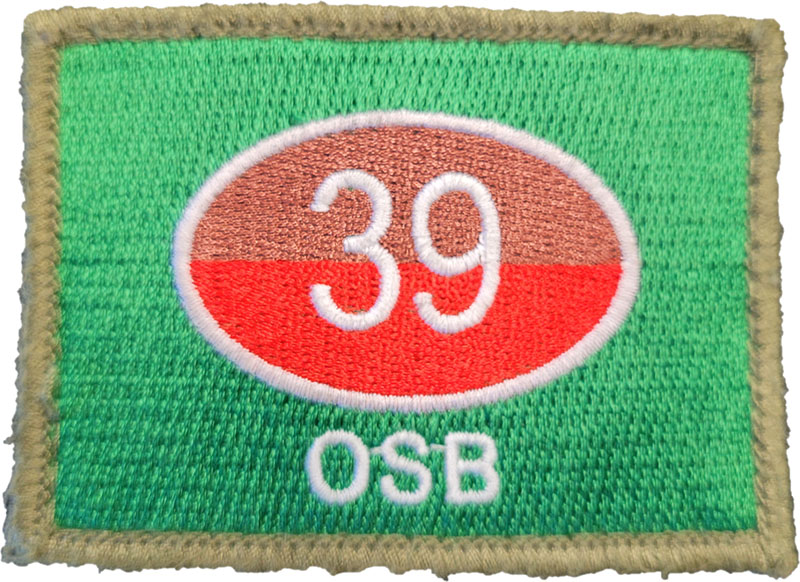
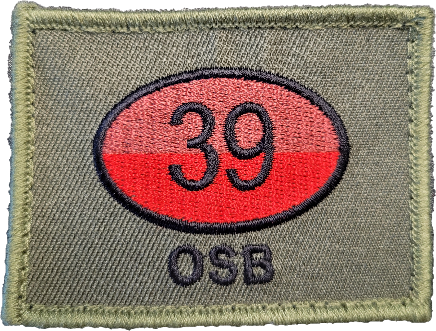
Current Barracks and Field Shoulder Patch worn by members of the unit
39th Operational Support Battalion (2014-present)
The 39th Operational Support Battalion (39 OSB) was formed on the 27th of March 2014, when the 39th Personnel Support Battalion changed its name to the 39th Operational Support Battalion.
The 39 OSB Mission is to support the operational generation and sustainment of directed ADF operations and activities IOT enhance joint capability and force protection.
39 OSB is an Army unit with personnel from the three services. It employs regular and reservist members from across the ADF, alongside Australian Public Service (APS), and utilises contractor support to deliver training. In May 2019, 39 OSB moved into its current facility located in buildings 401/404 at Randwick Barracks and those buildings were renamed Isurava Lines. Previously these buildings belonged to JLU (E) but have undergone a significant transformation to create an all-weather, multi- purpose, and custom built Force Preparation training facility. The unit consists of a Battalion Headquarters, Force Preparation Company, Administration cell, Logistics cell, Operations cell, a Training Development Cell (TD), and from 2008 – December 2021, a Reception Staging and Onward movement (RSO) team deployed on a rotational basis to Joint Task Force 633 located in Al Minhad Air Base, UAE. remotely.
SB has supported force preparation for the following operations:
Operation ACCORDIAN ( Middle East Region)
Operation HIGHROAD ( Afghanistan)
Operation OKRA (Iraq and Syria)
Operation STEADFAST ( Iraq)
Operation ASLAN ( South Sudan)
Operation PALADIN ( Israel)
Operation MAZURKA ( Egypt)
Operation LINESMEN ( South Korea)
Operation ORENDA ( Mali)
Operation CHARTER ( Cyprus)
Operation SLIPPER ( Afghanistan)
Operation FORTITUDE ( Syria)
Operation MANITOU (Middle East Region)
Operation ARGOS (Japan)
Multinational Force Observers (Sinai)
Domestic Response Operations (Australia)
South West Pacific Activities
Rifle Company Butterworth (Malaysia)
Currently 39 OSB is tasked to deliver force preparation training in support of ADF operations. In accordance with Direction from 1 DIV, 39 OSB is the mounting HQ and certification authority for United Nations and Other Operations as well as Army individuals deploying on operations. It is responsible to deliver amenities, and to examine and review force preparation training based on operational need. This training is delivered through Force Preparation Courses (FPC) residentially, as ‘fly-away’ courses, and online. FPC support pre-deployment training for members deploying to the Middle East Region (MER), on Domestic Response Operations, and on United Nations and Other Operations (UNOO). 39 OSB also conducts the Civilian Entertainers (CIVENT) Force Protection Course as required.
Residential courses are conducted at Randwick Barracks Sydney, with the capability to surge the number of courses conducted if required. Fly-away courses are conducted in support of formed-body deployments for Army units and for RAAF teams; these courses are conducted in all major defence areas. In 2020, in response to the COVID-19 pandemic, 39 OSB increased its capability to conduct online training to conduct FPCs remotely.
39th Operational Support Battalion Commanding Officers:
LTCOL S.A. Rowland, CSM
25 March 2014 – 17 January 2016
LTCOL K. Juchniewicz
18 January 2016 – 14 January 2018
LTCOL K. Holbeck
15 January 2018 – 12 January 2020
LTCOL L. Weston, CSM
15 January 2020 – 16 January 2022
LTCOL D.P. Ready
16 January 2022
39th Operational Support Battalion Regimental Sergeant Majors:
Warrant Officer Class One E. Penman
25 March 2014 – 18 January 2015
Warrant Officer Class One D.S. Vallely
19 January 2015 – 15 January 2017
Warrant Officer Class One R.A. Rootham
16 January 2017 – 20 January 2019
Warrant Officer Class One M.J. Reyne, OAM
21 January 2019 – 12 January 2020
Warrant Officer Class One J. Hayes
13 January 2020 – 17 January 2021
Warrant Officer Class One T. Adcock
18 January 2021 – 15 January 2023
Warrant Officer Class One A. Bungate, CSM
16 Jan 2023
EXERCISE KANGA’S RETURN
Initial concept 2017
Over the period 05-15 Aug 2017, 39 OSB conducted a trek of the KOKODA TRAIL to commemorate the 39th Battalions actions in Papua New Guinea (PNG). The activity was called Ex Kanga’s Return 17 (Ex KR 17). The Exercise was named after Alan ‘Kanga’ Moore, a 39th Battalion veteran. The key objectives of Ex KR 17 was to commemorate the 75th anniversary of the 39th Infantry Battalion actions in PNG, as well as provide a professional development opportunity for participating members.
A combined team of 29 personnel, including 23 from 39 OSB and 6 from Army Headquarters, departed Australia on 5 August bound for Port Moresby. After an overnight stay at Sogeri Lodge, the trekkers then boarded charter aircraft for Kokoda. The local population had a special welcome for the group including traditional dancers and the opportunity to visit the Kokoda memorial and museum. The memorial houses an honour roll of the 39th Infantry Battalion.
Each day along the track, Peter Morrison, one of the PNG guides, provided in-depth knowledge of battles and the personal sacrifice experienced by the men of the 39th Infantry Battalion while fighting the Japanese. Members of 39OSB had been paired up before they departed Australia and were given an historic topic to brief during the exercise. These were delivered at the end of each day by one of the pairs.
The people of PNG knew that 39th Infantry Battalion personnel were walking the track and every village came out to see the trekkers when they arrived in their location. The link between Australia and PNG is strong. The carriers provided for the Kokoda Trail walk were descendants of the Fuzzy Wuzzy Angels who played such an important role in World War 2. To be a carrier on the track is still today, one of the most honourable things a native of PNG can do. It is very important to their culture. On Exercise Kanga, all members of 39 OSB carried education resources and to give to the villages as they passed through them.
A tour highlight was the conduct of the dawn service at Isurava, including the site where Private Bruce Kingsbury (2/14th Battalion) earned a posthumous Victoria Cross. The words on the four pillars-Courage, Endurance, Mateship and Sacrifice embody the characteristics of the brave men that fought at Isurava.
Enduring connection
Despite being an annual activity since 2017 to send two people per year to walk the Kokoda Track, the impact of COVID-19 meant that the activity had not been conducted for some years. In 2022, 39 OSB planned and executed Ex Kanga’s Return 22 (Ex KR 22), leading a combined contingent of 39 OSB and other Army unit personnel across the Kokoda Track. Ex KR 22 was a significant milestone as it commemorated the 80th anniversary of the Kokoda Campaign. It also included a ceremony to scatter ashes of the last surviving officer of the original 39th Infantry Battalion, Alan ‘Kanga’ Moore, who passed away in 2021. The activity was an amazing experience for those who went and gave way to the idea of shaping Ex KR into an enduring activity focussed towards junior leaders across Army.
Ex KR is now an annual event that is part of the Olgetta Warrior series of engagements with the PNGDF each year. The concept is for the annual Ex KR to be 39 OSB planned and led, which aims to include junior leaders from across Army as a leadership development activity. The Kokoda campaign contains many examples of exceptional leadership during times of hardship, danger and stress. The exposure of junior leaders to the arduous conditions of the Kokoda Trek, coupled with the historical and military context, will positively shape their leadership while also exposing them to the region. The target audience for Ex KR are JNCOs / LTs who demonstrate strong leadership potential and have performed to a high standard.
Ex KR will occur annually over 12 days in the period late July to early September. This will facilitate stronger historical relevance as the trek will occur around the dates of key battles involving the 39th Infantry Battalion including the Battles of Deniki and Isurava, as well as the AIF stand at Brigade Hill. The activity will also include 1 – 2 days either side of the trek in Port Moresby to allow for a commemorative service at Bomana War Cemetery and to visit other key historical sites. It is intended that this enduring connection will keep the legacy of the 39th Infantry Battalion alive and well into the future.
 Deployed Forces Support Unit (DFSU) – 1999-2006
Deployed Forces Support Unit (DFSU) – 1999-2006
Deployed Forces Support Unit (DFSU) was raised on Nov 17, 1999.
The role of DFSU was to provide personnel services support to deployed forces, including administrative preparation, training, welfare, amenity and financial services of all ADF members on designated Headquarters Australian Theatre mounted operations, and Land Headquarters mounted overseas operations. DFSU was raised to coordinate the preparation and support to all ADF elements deployed on overseas operations.
DFSU was tasked to undertake the following functions:
-
- Assume command of the existing sub unit, Deployed Forces Support Unit – Sydney, (DFSU-S)
- Assume command of the National Welfare Coordination Centre, (NWCC)
- Assume command of the 1st Joint Amenities Unit, (1 JAU)
- Raise a new force preparation sub-unit, Force Preparation Squadron – Darwin, (FPS-D).
In Dec 2001, DFSU was tasked to raise a new Reinforcement Holding Company (RHC) and develop the doctrine and procedures for the training, reinforcement and redeployment of individuals to operations.
In Aug 2002, NWCC was reallocated under operational command of Headquarters Australian Theatre (HQ AST), but remained under the administrative command of DFSU.
In Dec 2003, FPS-D was amalgamated with DFSU to form a single force preparation squadron, (FPS-S) located at Randwick Barracks, Sydney.
In Aug 2004, the Deployed Forces Cash Office (DFCO) was allocated under the command of DFSU. The DFCO was located at Enoggera Barracks, Brisbane.
In Sep 2004, the FPS-S was retitled Force Preparation Squadron (FPS).
DFSU was a direct command unit of the Logistic Support Force (LSF). DFSU consisted of a Headquarters and support elements located at Randwick Barracks, with five distinct and separate elements under command.
The elements and their locations were:
-
- Force Preparation Squadron (FPS) – located at Randwick Barracks, Sydney.
- 1st Joint Amenities Unit (1 JAU) – located at Robertson Barracks, Darwin.
- Deployed Forces Cash Office (DFCO) located at Enoggera Barracks, Brisbane.
- Reinforcement Holding Company (RHC) Located at Randwick Barracks, Sydney.
- National Welfare Coordination Centre (NWCC) located at Randwick Barracks, Sydney.
DFSU conducted six core force preparation courses for ADF operations and UN deployments as follows:
-
- Operation CATALYST (Middle East, including Afghanistan)
- Operation SPIRE (East Timor, UN Peace Keeping (PK) Ops/UNMISET/DCP-EM)
- Operation ANODE (Support to multinational regional PK force in Solomon Islands)
- Operation PALADIN (MEAO PK Ops/UNTSO)
- Operation MAZURKA (Sinai MFO Ops)
- Operation POMELO (UN PK Ethiopia/Eritrea/UNMEE).
Get in Touch
For all email enquiries, please submit the form.
If you are a member, committee phone details are available in the Good Guts. LOGIN to check.
All mail to: 39 Battalion Association
PO Box 552, Gisborne VIC 3437
